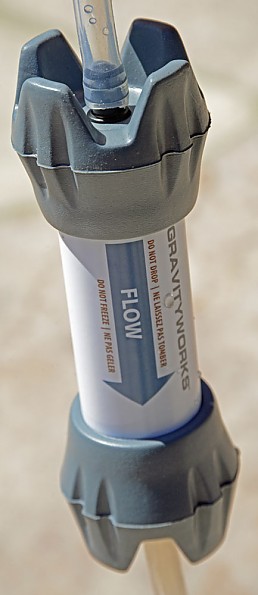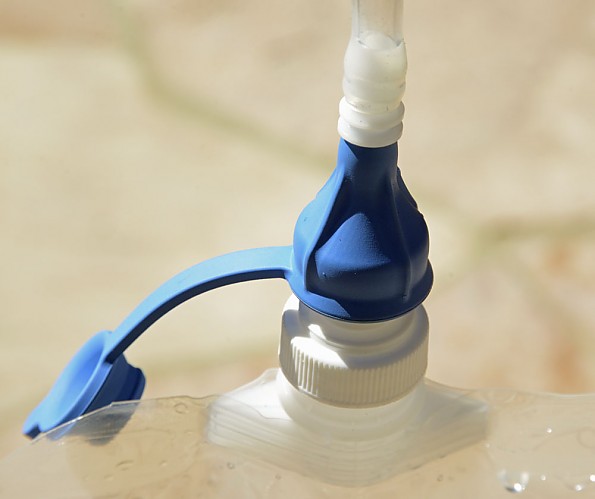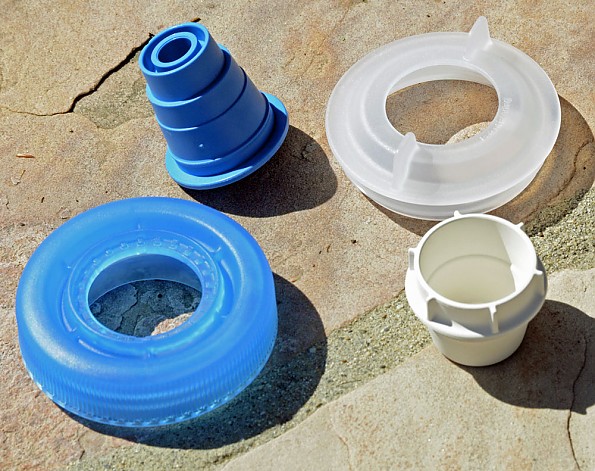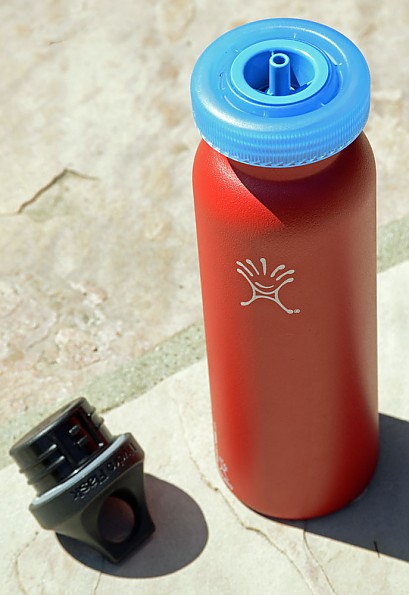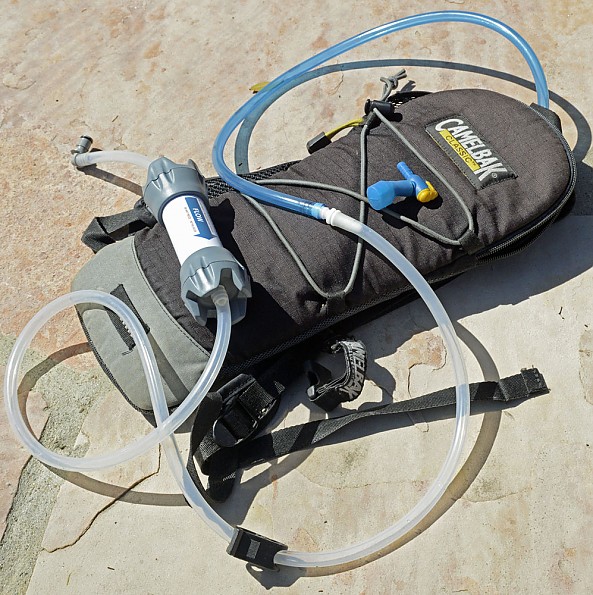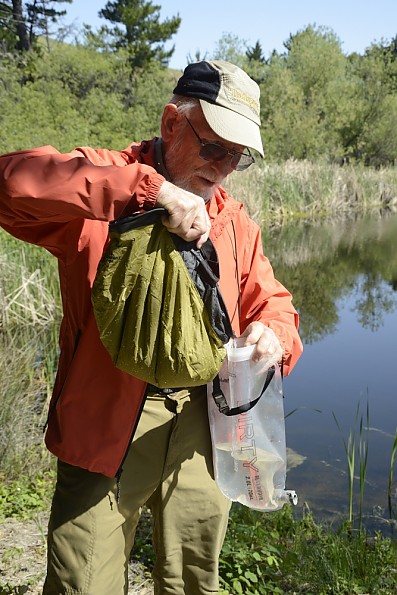Platypus GravityWorks Filter System 2L

I've used the Platypus GravityWorks for about a year now. Extremely easy to use and the best part... It requires NO pumping. It's also lighter compared to some of the other water filter systems out there (especially when you ditch some of the hydration connection components that may be unnecessary based upon each individual's hydration carrying method).
Pros
- Lightweight
- Easy to use
- NO PUMPING!
Cons
- Pricey compared to pump options (Saw the Katadyn Hiker PRO at the time of this review for 60 bucks at REI)
- The Sawyer option comes with the million gallon guarantee, while the Platypus has a filter life of 1,500 liters.
While writing this review, I am resigned to note that whatever I write, I'll probably not get anywhere close to Bill S's review, in terms of attention to detail, quality of the review, etc. etc. Actually, his review was part of the reason why I chose the GravityWorks system in the first place. But here are some of my personal experiences with the GravityWorks 2L:
Effectiveness: So far, I've had nothing but good experiences with the GravityWorks. I've never gotten sick from the water I've consumed from water treated with the GravityWorks, but I've also only used the product domestically in the United States.
According to the product, the filter physically removes particles, protozoa, and bacteria down to 0.2 microns in size, including giardia, salmonella, cryptosporidia and others. From a personal experience, I've always had great tasting water when treated with the GravityWorks. I've used it with water sources ranging from alpine lakes, streams, and rivers.
Speed & Efficiency: Platypus claims a flow rate of 1.5 liters per minute. Of course, backflushing the GravityWorks periodically will improve the flow rate of the filter. While I have never actually timed the claimed 1.5 liters per minute flow rate, I did have an experience in Cottonwood Lakes in the Sierra last summer where I used the GravityWorks while a fellow buddy of mine used a traditional pump system. Needless to say, the GravityWorks was much faster and easier compared to my poor buddy pumping away.
Capacity: While I only purchased the 2L version, it does treat enough water for groups based upon the ease and efficiency of use. I've used the GravityWorks for groups of four and water filtration duties are a breeze.
Furthermore, since the Gravity Works comes with an assortment of components for hooking up to hydration bladders, Nalgenes, and push/pull caps, the GravityWorks is perfect for groups of hikers who have varying individualized hydration systems for carrying water. In terms of weight, for a group of 4, that only comes out to be 3 ounces per person for a water filtration system!! (Total claimed weight of the GravityWorks: 11.5 oz)
Ease of Use: The Gravity Works is EXTREMELY easy. Simply fill the dirty bag, connect the components, and let gravity run its course. While the Gravity Works is commonly shown hung from a tree branch, I've often hung the dirty bag around my neck when branch hangings aren't easily found.
Sounds a little silly, but on trips to alpine lakes during hot days, hanging the dirty bag around my neck was actually quite pleasant, as the water in the dirty bag helped cool my core while filtering water. But of course, the best part of about the GravityWorks is that there is NO PUMPING INVOLVED.
Cleaning of the product is also quite simple. Two drops of bleach for every 1 liter of water helps disinfect the system for long time storage and after long term usages. A simple backflushing of the GravityWorks also helps improve the flow rate of the filter.
Features: The filter life of the GravityWorks is rated to 1,500 liters. This is a little disappointing knowing that the Sawyer version has a million gallon guarantee at the same price. However, the GravityWorks is lighter compared to the Sawyer system (Sawyer 2L System claimed weight: 16 oz).
Construction & Durability: After a year of use on multiple trips, I've had no issue with the construction and durability of the GravityWorks. Disinfecting the system assists in any smells or bacteria growth when storing the product for long periods of time. As aforementioned, backflushing the GravityWorks helps improve the flow rate after multiple uses. So far, after a year of use, I've had no problems.
Conditions: I've used this product mainly in California (Sierra, Angeles National Forest, and once in the Cascades in Oregon) during warm spring/summer/fall months so I cannot attest to its ability in cold/below freezing weather.
Price: As noted above, there are other less expensive water treatment options out there, such as the Katadyn Hiker pump system. However, at the time of this review (May 18, 2014), I saw that the GravityWorks 2L is on sale for 80 bucks at REI, 30 bucks cheaper than the usual price.

Use of Gravity Works at Sykes Hot Springs in Big Sur:
Here's another pic of the GravityWorks in use in the Sierra last summer (sorry for the gratuitous "bending over in front of the camera" picture):
Source: bought it new
Price Paid: 110 bucks
Overall I found the Platypus GravityWorks 2 liter to be a convenient and easy approach to the problem of providing potable water. No water treatment system is perfect, of course. Backpackable systems do not sterilize the water, but rather purify it to a level safe for drinking. No system suitable for backpacking removes industrial, agricultural, or mining runoff. Pump and gravity filters like the GravityWorks do not remove all viruses (except for those filters using an auxiliary iodine matrix). The weight is reasonable compared to other approaches to water treatment in the backcountry.
Pros
- Versatile (fits many water containers)
- Lightweight and compact (full kit 12 1/8 oz., light for hydration bladders 7 5/8 oz)
- Easy to use and maintain
- Very rapid treatment (measured 40 sec/liter, spec 1.5 liters/min confirmed).
- Waterproof instruction sheet permanently attached to storage bag
- Filter pore size of 0.2 microns blocks all protozoa, most bacteria, and some viruses
Cons
- Filter pore size is 0.2 microns, so some viruses can get through
- Cannot be used for water with ice in it or at temperatures below 32°F/0°C (allowing the filter to freeze will create voids in the filter element that allow contaminated water to flow through unimpeded).
- Can easily get air-locks in line when starting filtering and when back-flushing
- Requires back-flushing frequently (manufacturer’s recommendation after every 2-4 liters)
- As with all filter systems, care is required to prevent cross-contamination of components
Water Quality
As I discussed in my 4-part review of water treatment systems and in my more recent review of the ultraviolet-based Camelbak AllClear system, when I was growing up and when I began going into the woods and hills on my own, we drank from streams, lakes, whatever water was available, with no real concern about what was in it. My mother, who grew up in rural Missouri, told us that water in the creek was safe after it had flowed over three rocks (even if there was some dead animal just upstream). If it was murky, we let it settle for a while and maybe strained it through a piece of muslin to get most of the sand, gravel, sticks, and other junk out. We lived for a while in Central America and never worried about the water out of the tap.
The "test kitchen" for the GravityWorks,
an Ohlone "Grinding Rock"
As a teenager and into my late 20s, when backpacking and climbing in the Sierra and Rockies, we would dip a cup in the stream (or just lay down on the bank and stick our faces in the water) for a drink. In some areas, such as during the dog sledding expedition I went on in Alaska in late March 2013, I still often just drink directly from water sources that I judge to be safe. I suspect that, being exposed to so many critters, I have developed some immunity, because there were times when companions would become ill, usually a week or so after the trip, while I did not.
There was one major exception — I grew up during the era when the dreaded polio (poliovirus diameter 27 nm or 0.027 micron) was rampant. Since it was suspected to be transmitted through swimming pool water, we were never to drink or swallow water from the municipal swimming pool. Note that the poliovirus diameter of 0.027 microns is about 10x smaller than the GravityWorks pore size of 0.2 microns.
Many backcountry travelers drink from the streams and lakes without ill effects. But others get extremely ill. The problem is that as soon as we wander more than a few feet from “civilization,” there are no guaranteed safe sources of water. I discuss the question of water and what’s in it in some detail in my four-part article, "Backcountry Water Treatment" here on Trailspace.
The problem is even more critical when we go to some foreign country. Even straight out of the tap in a fancy hotel, the water may subject us to Montezuma's revenge, Aztec two-step, backdoor trots, beaver fever, loose stool, runs, summer complaint, tourista, trots, Pharaoh’s revenge, mummy tummy, Delhi belly, and many other terms. These complaints are estimated to hit 20 to 50 percent of travelers. Foreigners coming to the U.S. suffer from our “pure” water and food, too.
Staying properly hydrated and healthy is fundamental to having an enjoyable experience. And that means having safe water to drink. But people get sick despite having treated their water or even packing it in. Trailhead interviews of backpackers in the U.S. and Canada point to personal sanitation and careless handling of food as the primary sources of problems rather than contaminated water. Still, even with diligent hand washing and using sanitizing hand cleaners such as Purell™, it is a good idea to treat the water you get out of the streams and lakes. Not all people in the backcountry diligently follow Leave No Trace principles and practices. And there is a reason that giardiasis is also called “beaver fever”.
Water Treatment
There are several classes of water treatment suitable for the backpacker — boiling, halogen tablets (chlorine and iodine), filters, and ultraviolet radiation. All these methods have their advantages and disadvantages. You can also buy bottled water when travelling, except that some sources of bottled water just re-fill the bottles from the tap.
I have collected and used examples of all of these methods over the years. These approaches, combined with diligent hand washing and sterilizing, plus careful handling of food, have kept me almost free of the affliction in the backcountry in 3rd world countries as well as in the US, Canada, and Western Europe. Note I said “almost free”. The few times when I was pretty miserable were most likely due to poor handling of food.
The most likely sources of illness from water are microorganisms like bacteria (E. coli for example) and protozoa (giardia and campylobacter, for example). Viruses are less likely in alpine environments like the Sierra, Cascades, or Rockies.
As a broad generalization, filters will remove bacteria and protozoa, but will pass most viruses, since backpacking filters have pore sizes no smaller than 0.1 micron. The hepatitis B virus is 0.042 microns, for example.
Halogens, in the form of tablets (Aquamira, Potable Aqua, and other iodine and chlorine-based brands) or solution (plain, unscented chlorine bleach) will kill bacteria and viruses, and, with sufficiently long times, protozoa (at least 4 hours to more than 24 hours, dependent on temperature). Ultraviolet light will kill or inactivate all the microorganisms. However, all ultraviolet systems, except solar exposure, depend on batteries, hence require carrying a sufficient supply or having a solar panel or other electric source.
The instructions that come with the Platypus GravityWorks specify that you back-flush the filter every two to 4 liters, and after your trip, you treat with chlorine bleach before you store the filter or after long-term use (15+ days). All filter manufacturers, whether pump or gravity, specify similar maintenance guidelines. An important caution is that you should store the “clean” and “dirty” components of the system separately to prevent contamination.
Product Details
The box contains “dirty” and “clean” bags, hoses, filter, and adapters for various bottles, as is now typical of gravity-feed filtration systems. There is a storage bag with two compartments, one of which has instructions for use printed on a waterproof plastic flap attached to the storage bag. The unit shipped to me for testing is the 2 liter size, list priced at $109.95 at some shops and $99.95 at REI and other stores. There is also a larger 4 liter size, listed at $119.95 in some shops.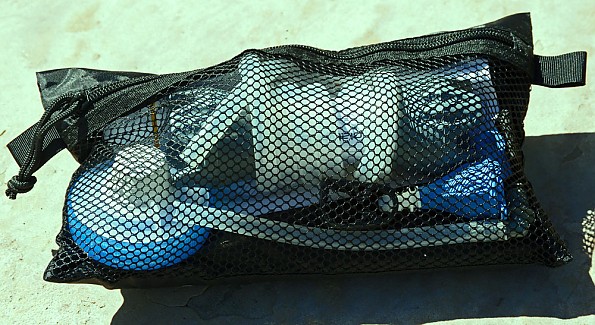
The GravityWorks in its storage pouch
As I opened the box and removed the contents (including directions in English and French, both of which I read, though not necessarily fluently in either), I compared the parts list to the items as I removed them (I have at times received packages that were short needed items, either because they were listed as “optional extras” or were just plain missing). All specified items were there, leaving me to spend some time figuring out how many of the various water-carrying containers I own could be fitted with no leakage. Cascade Designs (manufacturer of Platypus products) has done a fine job of adapters, covering the vast majority of the water bottles and hydration bladders that backpackers are likely to have these days. The main bottle top has a clever stepped-pipe design that fits a very wide variety of bottle openings, along with a double-ended press-fit adapter that fits most hoses.
The components of the GravityWorks and its box
I will note that, in my personal experience, the plastic out of which the Dirty and Clean reservoirs are made is not very durable. I have had this material (specifically some Platypus foldable water containers) crack after repeated folding and unfolding, especially when used in very low temperature conditions (my “cold temperature” use includes a lot of sub-zero F environments, including -40 to -50°F and below). The Platypus GravityWorks is not intended for use in subfreezing temperatures (below 32°F), as is true for all water filtering systems, so this may be a moot point. Some of the failures, however, have occurred in more moderate temperatures. 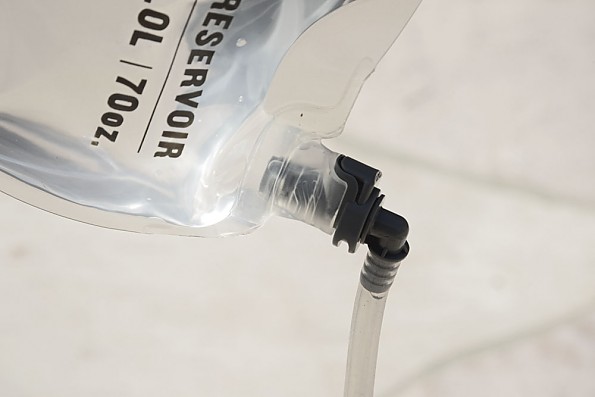
The quick-disconnect coupler attaches the short "dirty" hose
to the "Dirty" reservoir
The filter - water flows in the direction of
the arrow, from the black inlet and out the
white outlet through the "clean" hose
Setup
On receiving the package from Trailspace Gear Review Corps Central, I opened the box to examine the contents, and review the instructions. The supplied items consist of two transparent bags, one labeled “Dirty”, the other having only the “Platypus” brand name on it. The top of the “Dirty” reservoir has a zip-type (finger operated, no slider) closure and a 2 foot clip-type strap threaded through two reinforced holes to allow hanging the filled “Dirty” reservoir from a tree or convenient hook. The lower end of the “Dirty” reservoir has a female quick-disconnect coupler, which matches the male coupler on the short 6-inch “dirty” hose. The other end of the short “dirty” transparent hose is press-fit onto the knurled black (“dirty”) inlet end of the hollow-fiber membrane filter cartridge, specified to have a pore size of 0.2 microns.
The opposite end of the filter (the white “clean” outlet) gets connected to the long (42-inch) “clean” transparent hose The transparent hoses perform two main functions beyond simply transporting the water being treated – inspection for discoloration in the water (indicating contamination or filter failure) and allowing checking for air-locks. They also play a role in checking for bubbles during the Filter Integrity test, which would indicate internal breakage due to dropping or allowing water inside the filter element to freeze.
A ratcheting hose clamp is provided to slide onto the “clean” hose to control the flow of water through the system. 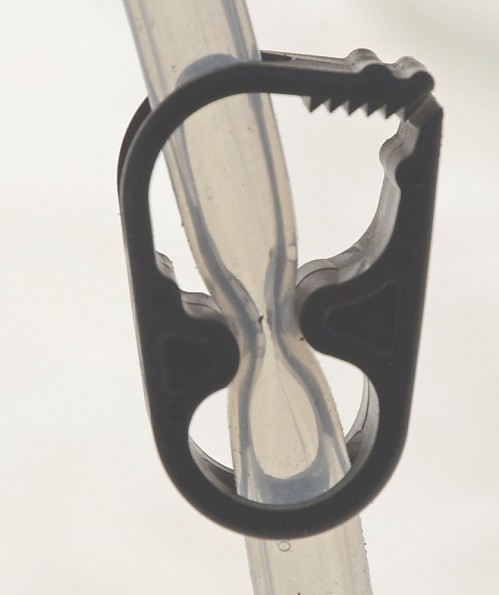
The ratcheting hose clamp in open position
A big plus for the Platypus is that both clean and dirty bags and the hoses are transparent. This gives a visual indication of the effectiveness of the filtering process and an alert in case the filter is clogged or compromised, as well as a visual check on air-locks in the system. Other gravity filter systems (such as my Sawyer) have opaque bags and hoses.
The hose adapter for the Platypus push-pull drink valve
The Platypus push-pull drink valve on the "Clean" reservoir
The versatile water container adapter system to match
a wide variety of water bottles and hydration bladders
The adapter on a standard 1 liter Nalgene water bottle
The adapter on a Hydroflask of smaller opening
Direct connection to the hose of a Camelbak hydration bladder
The Water Filtering Process
Where possible, for any water treatment process, I let the water settle for several hours or overnight, then decant the clearer water from the top through a couple layers of old cotton sheet into another container for treatment or filtering. For the Platypus GravityWorks (and other gravity-fed systems), this means pouring the water into the “Dirty” bag. During the testing, I both filled the “Dirty” bag by immersing it in the pond or creek and alternatively by filling my Sea to Summit “Kitchen Sink” (a 10 liter foldable bucket, also used in my 4-part article on water treatment). 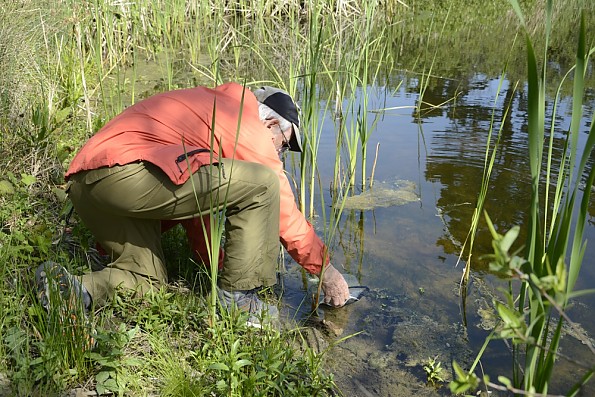
Filling the "Dirty" reservoir by directly putting it into the pond
Using the Sea to Summit 10 liter "Kitchen Sink" to collect water for drinking
Filling the "Dirty" reservoir from the "Kitchen Sink". Note that wearing an Official Trailspace Cap is necessary to insure a complete, accurate, and thorough review of any gear by the Trailspace Gear Review Corps!
The Platypus GravityWorks filtering process itself is very simple and rapid. Most of the steps are illustrated in the accompanying images. The Dirty reservoir is filled with water from the nearest stream or pond and the “zip” closure sealed by running your fingers over it and squeezing. Test that it is closed by inverting the filled bag. The Dirty bag is then hung at some height above the ground, preferably high enough that the hose line will be relatively vertical from the Dirty bag to the entry point of the clean hose into the Clean bag. The female quick-release connector at the bottom of the Dirty bag is closed until you insert the short hose connector into it (after assembling the rest of the system).
The Dirty reservoir filled with pond water,
ready to have the quick-release coupler inserted to filter
The next step is to assemble the feed line by attaching the short hose to the input of the filter by sliding it onto the black knurled connector (note the big arrow on the side of the filter body in the image above). The long “clean” hose is attached to the output of the filter by sliding one end onto the outlet white knurled connector. The ratcheting clamp is opened and slid onto the clean hose. I found it most convenient to place the clamp about 6 inches/15 cm from the filter. You now choose what container you will be feeding the filtered water into and attach or drop the outlet of the hose into it.
In the illustration, I show filling the Clean bag with the Platypus push-pull cap on it. For this, you attach the hose to the blue elastic cover that fits over the push-pull cap that you have attached to the Clean bag. Remember to open the cap. At this point, you insert the quick-release connector on the short hose into the connector on the Dirty bag. 
The assembled and filled GravityWorks filter ready to filter
The Clean bag does not need to be hoisted off the ground, though it can stand upright. As the images show, the receiving container should be about the hose length below the Dirty source bag. The clamp is then opened and the water will flow fairly quickly through the filter and into the Clean bag, bottle via the bottle adapter, or from the end of the clean hose directly into your bottle or hydration reservoir.
You may encounter an air-lock in the line. The illustrated instruction sheet that is attached to the storage bag shows one method of removing the air-lock, which is caused by one or more air bubbles in the line. Once the bubbles are removed (or more correctly, moved to the Clean bag or water bottle), the system filters the water fairly quickly, taking about 90 seconds to filter 2 liters of water. I have found with gravity filters that letting the first few ounces of water flow through the system and onto the ground tends to avoid air-locks. 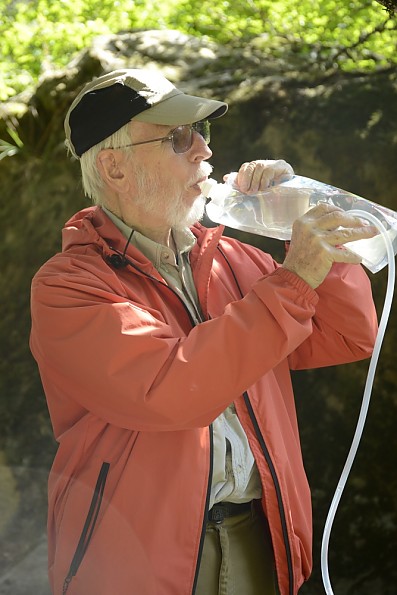
A refreshing drink of freshly filtered water!
Of course I drank it! That's part of the thorough
testing the Trailspace Gear Review Corps does!
Note that NO systems readily carried by backpackers are capable of removing industrial, agricultural, or mining runoff. Be aware of the sources of the stream or pond from which you are taking your water. Platypus includes this warning on the box, in the directions folder, and on the flap in the storage pouch. There are several popular regional open spaces in Almaden Valley, not far from where I live, that have all their streams and ponds contaminated by runoff from the old mercury mines in the area, notably in the ominously named Almaden-Quicksilver County Park.
Avoid cross contamination by making sure you:
- Do not allow untreated water to get into the “clean” parts of your system (hose, clean reservoir, water bottles, etc)
- Store the clean and dirty components of your system separately (I use individual Ziploc bags for each component, rather than just shoving everything into the two compartments in the provided storage bag, a habit I developed years ago with other filter designs).
- Back-flush as recommended every 2 to 4 liters of water
- For storage and on long (greater than 15 days) outings, disinfect the system as recommended with chlorine solution.
But what do you do for a month-long backpack or a thru-hike on the PCT (2,600 miles) or AT (2,200 miles)? Following the directions explicitly would mean back-flushing the system several times a day if you are using it for a group of 3 or more. Based on my experience with other filters, I would expect that back-flushing is only needed when the flow rate is noticeably slowed.
Some water sources (glacial melt or streams in volcanic regions) do clog filters more rapidly, which would require more frequent back-flushing. But even many of the shorter thru-hikes require most hikers more than the 15 days recommended in the instructions for the disinfection cycle. Personally, I believe that the recommendations for disinfection are overly conservative. However, as always, since I am not an MD or public health professional, I recommend following the manufacturer’s instructions.
Testing
I carried the GravityWorks on several short hikes and overnights. I did not carry it on an extended expedition, since (1) I needed to complete the evaluation in a fairly short period, and (2) the extended expedition I did go on was at high altitude and low temperatures, thus risking freezing the filter and fracturing it.
In tests with tap water, I found that the claim of 1.5 liters a minute was matched (40 seconds with the Dirty bag filled to the 1 liter mark and 1.5 minutes when filled to the 2 liter mark. When using somewhat murky pond water, I found that the rate slowed after a few Dirty bags full. Back-flushing as directed returned the flow rate to the 1.5 liter/min rate.
The GravityWorks worked fine on all outings. The taste of both the stream water and the murky pond water was as good as some of the pricey bottled waters. For many filters I have used, ponds as murky as the one in the images often have a noticeable taste even after filtering. In my experience, filters with an activated carbon element do remove much of the taste, though Platypus does not offer a carbon accessory.
This pond was one source for the filtering tests
Over the years, I have acquired a number of water treatment systems, including several pump filters and a competing gravity filter. A common complaint about pump filters is that they require a lot of tiring muscle power to get a liter of water. This is especially true of those filters which have sub-micron pore sizes, such as Katadyn’s Micro (0.2 micron pore size) and my Katadyn Hiker Pro (0.3 micron pore size plus carbon element).
By contrast, gravity filters like the Platypus GravityWorks require no muscle power, using the Earth’s gravity to do all the work, plus gravity is there all the time. In addition, the GravityWorks is lighter than most pump filters, particularly since you can use it in the “bottle”configuration and the Platypus Clean reservoir will serve as your hydration reservoir to go in your daypack.
Maintenance:
Filtering and UV water treatment systems require a certain amount of maintenance, which chemical treatment systems do not. Boiling requires carrying extra fuel, though no maintenance beyond that for the stove (which you have to do for cooking anyway) and cleaning the pots.
The maintenance of the Platypus GravityWorks is quite simple. In the field, the only thing you need to do for most trips is occasional back-flushing. This is done by simply inverting the system to run filtered water backward through the filter. The instructions advise regular backflushing every 2 to 4 liters, or if the flow is noticeably slowed, indicating clogging of the filter.
Fill the Dirty reservoir and run the water through the GravityWorks as usual, disconnecting the quick-release coupling on the Dirty reservoir, while there is still a half-liter or so of water remaining in the Dirty reservoir. This ensures that there is no air-lock in the line, along with a supply of clean water in the Clean reservoir to use in the back-flushing.
Next, raise the Clean reservoir a few feet and let water flow out of the quick disconnect coupling onto the ground for a few seconds or until the water runs clear. You can now lower the Clean reservoir and reconnect the quick-release coupling and resume filtering as usual. That is all there is to the back-flushing.
Back-flushing while leaving the Dirty reservoir attached
As mentioned above, after a couple weeks of constant use or when placing the unit in storage, it is a good idea to disinfect the system. This, too, is a fairly simple process, especially if done at home. First rinse the Dirty reservoir with clean water. Then fill the Dirty reservoir with 1 liter of clean water and add 2 drops of household bleach – the plain chlorine bleach that has no fragrance or dyes. Read the bleach bottle carefully to be sure it is pure sodium hypochlorite (the cheap store brands generally, not the nationally advertised brands). Be very cautious with the bleach, since it is poisonous and can cause blindness in concentrated form if you get it in your eyes and can bleach spots on your clothes if you spill it. Do not let small children in the vicinity.
Next assemble the filter system with the clamp closed. Hold or hang the Dirty reservoir with the now-chlorinated water above the sink or laundry tub, open the filter and let the solution drain through the filter. When completely drained, rinse all parts of the system with clean water and towel-dry the insides of the Dirty and Clean reservoirs. The filter itself will not dry inside, but the chlorine solution that remains will prevent growth of the nasty critters and biofilm.
If you have reason to suspect a possible fracture of the internal filter elements, the instructions include a simple Filter Integrity Test, which is to attempt to blow through the filter in the reverse flow direction. If you can blow through the filter in reverse, or blowing through the filter toward the Dirty reservoir, if you can see a steady stream of bubbles, the filter is compromised and should not be used, but must be replaced.
Operating Limitations
The operating limitations are unlimited on the high end (except by human tolerance) and no lower than 32°F/0°C, or water containing ice. Note that allowing the filter to freeze is likely to cause cracks in the multi-filament filter element, which would allow unfiltered water to get through.
Weight
The GravityWorks filter system can be carried in several different configurations at a wide range of weights, from light enough to satisfy the most avid Ultralighters to a more complete configuration that is still quite light.
Full kit to cover all possibilities on an extended trip – 12-1/8 oz
Filter, Dirty bag, hoses, hose clamp, and bottle adapter – 9-1/8 oz
Filter, Dirty bag, hoses, and hose clamp (fill bottle directly – 7-5/8 oz
Conclusions:
The Platypus GravityWorks 2 liter filter is compact, light weight, effective on most water sources found in North America, and easier to use and more rapid than pump filters. Given the caveat that it does not remove most viruses (rare in places like the mountains in the Northeastern U.S., the Rockies, the Sierra, and the Cascades), it is an excellent choice for backpackers.
My personal choice:
My personal choice for water treatment depends on the type and location of outing. I have and use all styles of treatment. All the approaches have their advantages and disadvantages. Filters and UV systems tend to be heavy, plus filters tend to clog, especially when the water source is from a melting glacier or a stream that runs through volcanic soil (such as in the Cascades). Chemical treatments take an extended time and tend to leave a disagreeable taste, with some chemical treatments having long-term health risks. Heating water to pasteurization temperature (155° F for 5 to 10 minutes, boiling is not necessary) requires extra fuel (water boiled over campfires often tastes of smoke and ash).
If I will have a source with clear water or can get the water clear enough with settling and a prefilter, I use the UV systems (the SteriPen or Camelbak AllClear) for my personal water (plus maybe one companion) for long day hikes, backpacks up to a week or so (longer if I carry my solar panel), and for third-world countries where I will be using tap water.
If the water is going to be turbid (full of glacial flour or volcanic ash, for example) I use a filter with prefiltering (Katadyn Hiker Pro usually, sometimes Sawyer gravity filter 2 liter), followed by either a UV treatment or chlorine dioxide tablets . Cooking water has to be heated anyway, so no further treatment is needed. I have been using UV treatment for tap water in foreign countries (a few times in a restaurant, when I was unsure of the source of their “bottled” water. But remember, you can’t use the UV treatment if there is ice in the water.
Having said that, based on my tests during the review, the lighter weight, and the transparent reservoirs and hoses, I will be making a lot of use of the Platypus GravityWorks 2 liter filter from now on.
Comparative weights of some water treatment systems as carried in the field:
Platypus GravityWorks complete kit: 12-1/8 oz
Platypus GravityWorks bottle kit: 9-1/8 oz
Sawyer 0.1 micron gravity filter 2 liter: 16.2 oz (including the two 2-liter bladders)
Camelbak All Clear (bottle, std cap, UV cap, case): 13.6 oz
Camelbak ¾ liter bottle with bite valve and non-filter straw: 7.2 oz
Camelbak Groove (¾ liter bottle with “straw filter”): 6.9 oz
The following do not include a bottle or other container. Container weight should be added:
SteriPen Venture Opti (UV) with batteries: 3.6 oz
SteriPen Venture contact (UV) in solar case with spare batteries (Opti is same): 11.5 oz
SteriPen Pre-filter: 1.5 oz
Katadyn Exstream XR (bottle with filter straw and “virus treatment”): 9.6 oz
Katadyn Hiker Pro pump filter kit (incl prefilter): 15.6 oz
Sweetwater pump filter kit (incl prefilter): 13.4
First Need pump filter kit (incl pre-filter): 14.2 oz
MSR MiOx kit (generates chlorine dioxide from rock salt and water): 5.8 oz
Source: received for testing via the Trailspace Review Corps
(sample provided by Platypus for testing and review)
This is another version of the Platypus GravityWorks filter systems in a 2 liter model that attaches directly to a water bottle rather than another reservoir. The unit comes with multiple attachments to allow connection from the filter output to a wide variety of bottles. As the name implies, the system uses gravity to draw impure water through the filter unit efficiently and without effort from the user.
Pros
- No pumping!
- Quick. 2 liters in under 2 minutes.
- Filters bacteria and protozoa down to 0.2 microns
Cons
- Cannot allow filter to freeze

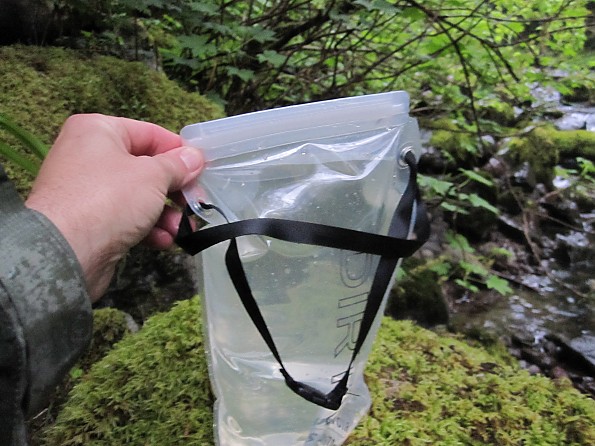

I bought this system as a lighter weight alternative to the MSR Miniworks EX. I also wanted an effective means of filtering without a lot of effort or time involved. The GravityWorks delivered.
When I took the "dirty" water reservoir down to the creek to fill, the first thing I noticed was how easily I was able to fill it and without completely submerging it. I then walked back up to camp, attached the filter to the self sealing quick disconnect of the reservoir and the "clean" side to a water bottle. I hung the reservoir and watched it fill.
Compared to the Miniworks, it was fast and filled two 1 liter bottles in under 2 minutes. That time includes the bottle switch. The Miniworks, takes over 2 minutes for 1 liter and is quite a workout to force water through the filter with the hand pump. I also liked the fact that I didn't have to stay right at the creek until the filtering was completed.
The filter uses hollow fiber technology and the manufacturer states it will last 1500 uses. The best part, no moving parts to break. The unit also assembles and stores easily. In general, I am sold by it.
Source: bought it new
Price Paid: $99.95
This is a great water filtration system. It's very light and suitable for long backpacking treks. Not the fastest system but filters water for the least amount of work.
Just fill the "dirty" reservoir bag from a stream or lake and hang it from a tree or nail on the side of a shelter. Then hook the filter and finally the "clean" bag at the bottom. Now go off and do something else while the filter and gravity do the work for you.
This filter physically removes particles, protozoa, and bacteria down to 0.2 microns in size, including giardia, salmonella, cryptosporidia and others.
It takes about three to five minutes to filter 2 liters of water. If you notice the flow is slow you can hold up the clean bag briefly effectively reversing the flow and clearing any debris from the filter. This usually restores a good flow.
This filter treated water for both my son and I as we hiked the Long Trail in Vermont. We would usually filter during a lunch break or after making camp in the evening. Was perfect for the two of us, but might be slow for a larger group.
It's very easy to use this filter. No moving parts to break. Everything works fine and flawless.
I've had this filter for over three years and have had no problems with quality. I replaced the filtration cartridge after two summers of use. The newer filtration is even lighter than the old one.
I'm very pleased with this water filter.
Source: bought it new
Price Paid: $100
Simple, quick, reliable, light, easy to use, easy to store. I will not replace this any time soon.
Pros
- Light
- Very easy to use
- Very fast
- Reliable
Cons
- Occasional clogs (but easy to fix)
I switched from an MSR Sweetwater two years ago and I love this Platy Gravityworks. I won't switch any time soon.
It's very fast—scoop up some water in the dirty bag, hook up the hoses and clean bag, hang it on tree and go set up your tent or do whatever. It's done in a couple minutes. It's easy to clean, easy to store, no pumping. It's much better than the pump systems
It can clog with sediment or air bubbles. In that case you either add some clean water to the clean reservoir or let it fill the clean one slowly for a couple minutes, then squeeze clean one to backwash it. Problem solved.
I've used it in very cold temps and had no issues, but I did have to keep it in my bag at night.
Source: bought it new
Price Paid: $100
Excellent and easy way to filter large quantities of water in the backcountry.
Pros
- Lightweight
- Easy to use
Cons
- Stuff sack a bit cramped
Purchased the Sawyer 2-liter gravity system, only to have it clog permanently after first use. Returned it and got the Platypus and not only is it lighter and more compact, it's much easier to use and is more versatile. Plus, it's fast! Clocked it filtering 2 liters at 1 minute 33 seconds. Not bad. It can be a bit of a struggle to fit all the components into the stuff sack but that's minimal compared to how well this system works.
Highly recommended.
Source: bought it new
Price Paid: $109.95
Your Review
Where to Buy
You May Like
Specs
| Price |
Historic Range: $54.95-$125.95 Reviewers Paid: $99.95-$110.00 |






